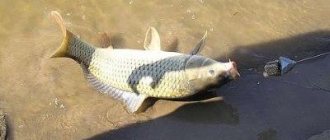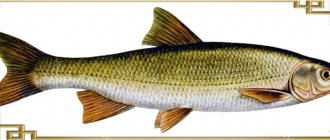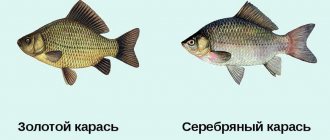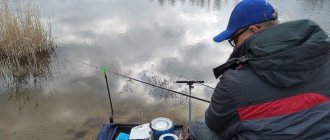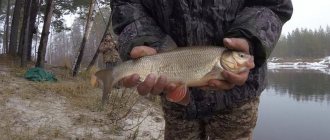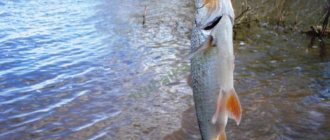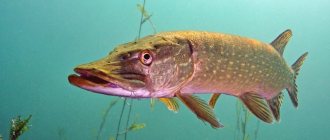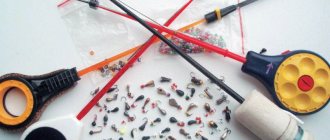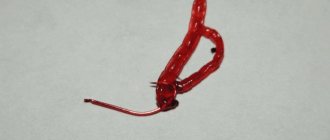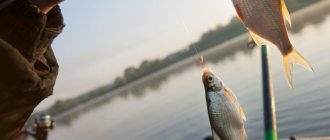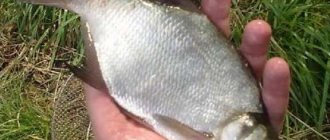Where to look for roach in autumn
As summer passes, the temperature of the water, as well as the environment, becomes lower. The main food of roaches, and these are larvae and worms, sink to the bottom and burrow into the silt. There is little food left, although she needs little food during this period. It becomes passive, so active biting is observed for a short time during the day.
Such changes in behavior require a more scrupulous attitude to the choice of equipment, bait and bait. With the right attitude towards your favorite pastime, autumn roach fishing can turn out to be exciting.
On the river
If the river is large, then roaches gather in large holes in the fall, and on a small river in October at shallow depths in the coastal zone. In addition, you can find places where small streams and various tributaries flow in. A large amount of food comes to such places with water and attracts fish.
On a small river in October, roach lives at shallow depths in the coastal zone. Especially when there are algae nearby, where there are abundant food supplies. As the temperature drops, the fish begin to actively move from shallow depths; they are depleted of oxygen due to the decomposition of algae.
On a still pond
Where there is standing water, you should choose steep banks with bushes as a place for fishing. Roaches also accumulate where aquatic vegetation grows abundantly. You can be sure of its presence when there are snags and driftwood, trees above the water. A good bite is observed in places where rivers of different sizes flow in.
Lure
Before fishing, the fish must be fed. The main purpose of complementary feeding will be to collect, stimulate appetite and keep roaches in one place. To prepare the mixture, water must be taken from the reservoir in the place chosen for fishing. Use moistened clay or coastal soil as ballast. Therefore, it is necessary to prepare dry fertilizer in advance at home, and mix it in the form of small balls upon arrival at the river or pond.
According to the goals set above, the bait should be made of small particles. To do this you need to use:
- breadcrumbs;
- ground rolled oats and wheat;
- oatmeal;
- various cakes.
The addition of dried daphnia and cyclops, used to feed aquarium fish, has a positive effect on the composition of the feed mixture. Such crustaceans can be caught independently at the end of summer with a gauze net in warm and shallow ditches and puddles filled with water, and then dried. It is useful to improve the quality of food with finely chopped worms, bloodworms and maggots.
Important tips when weaning
To increase your catch efficiency, you should know the following simple factors:
- Feed color. Roach is the favorite food of predatory fish. As a result, camouflage from pikes, perches and other predators is required. Therefore, when the bottom is dark, the roach acquires a similar color on its back. The applied complementary food, spreading on the bottom like a bright spot, will reveal a school of roach, which will immediately begin to be hunted.
- Do not feed the roach. Feeding should stimulate the appetite and concentrate a school of fish in a small space. This must be done by starting feeding. So, up to five balls prepared from the mixture, made from raw clay to increase the volume by half, are thrown into one place.
- The ratio of the size of animal ingredients to the parameters of roach. For small fish, you need to add a small amount of bloodworms and maggots to the complementary food, increasing the amount when large samples appear.
- The use of astringent components when fishing in fast water. For such cases, universal industrial feeds containing brown lactose for stickiness are a positive recommendation.
Gear selection
Roaches rarely swim to the shoreline in the fall and live in holes, responding poorly to attempts to attract them. For fishing you will need a rubber boat; this material is the most suitable. Even if something falls to the bottom, it does not make any noise and does not scare away the fish.
Feeder
When fishing for roach in the fall on a feeder, if you know well the deep places of the reservoir where fish gather in schools, you can count on successful fishing. With this method of fishing, you need to choose a place on the river with a strong current. You first need to make bait, and strong currents will help distribute it over a large space, facilitating the collection of roach in one place.
You need to purchase a rod 4-4.5 m long with a sensitive end and test - 150 g. You should also stock up on an inertia-free reel with a spool size of no more than 3000, monofilament fishing line with a diameter of 0.2-0.25 mm, the main fishing line - braided with a diameter of 0. 1−0.14 mm, fluorocarbon leader and paternoster or Gardner loop.
Given the small size of this fish, this type of equipment is best suited. It is highly sensitive and when even small fish start to bite, it signals the tip of the fishing rod.
When mounting, you must first wind the fishing line onto the reel and secure it to the rod rings. 50 cm from the tip of the feeder you need to make a loop on the fishing line to place the feeder on it. And at a distance of 15 cm a knot is made, to which a leash consisting of a fishing line and a hook should be tied.
The best option when fishing in fast currents is considered to be a monofilament line. It has great strength, despite its small diameter, and is able to withstand even large fish.
Float rod
In autumn, the water in reservoirs becomes much cleaner. Microorganisms that cause river blooms settle to the bottom, so the fish becomes especially careful. You should use inconspicuous equipment so as not to spook the roach.
First of all, you need to change the fishing line to a thinner one. If a fishing line with a diameter of 0.16 mm was used during summer fishing, then the cross-section of the new one should be no more than 0.12 mm. Its material should be durable, as transparent and invisible as possible. Leash lines are selected with a diameter of 0.08−0.1 mm.
The same requirement for hooks: inconspicuousness and strength. You need to use No. 3-5, thin and pointed. It is not necessary that the hooks be expensive, but of the highest quality; even cheap products will be in demand.
The float is used in a small size, with a thin antenna and a carrying capacity of no more than 0.5 g. You can even use a goose or chicken feather as a bite alarm; this method is effective, because at this time of year the bite can be sluggish and almost unnoticeable. Using a large or heavy float will not promote sensitivity, and you may miss a considerable portion of bites.
The color of the float is of great importance. If the water is dark, then the upper part of the alarm should be light, and in a transparent body of water it should be dark. The length of the rod must be at least 6 m so that you can cast the bait to the right place. The sinker must match the sensitivity of the equipment. The most commonly used is a lead ball.
Homemade bottom rigs
The bottom tackle should be thin and sensitive, the length of the rod is 5-7 m. A drop-shaped float with a load capacity of 4-8 g is attached to the main line with a diameter of 0.14-0.2 mm. At the end of the main line there is a loop or carabiner for attaching a replaceable leash. The sinker is installed above the leash attachment point. The length of the leash is 20-30 cm, the diameter is 0.12-0.17 mm, and the hook is No. 12-15. This equipment is universal; it is also suitable for catching rams in the fall.
Catching roach (roach) in late autumn
Autumn time of eyes charm (c)
Still, there is something in the words of the classic! Residents of the continent of Eurasia, namely its middle zone, have a unique opportunity to fully see all four periods of the life of the planet: hibernation, spring awakening, summer riot of colors and autumn preparation for bed. At the moment, while the white blanket has not yet covered the ground, autumn is preparing for sleep, both on the ground and in bodies of water.
As the water gets colder, life in the pond changes dramatically. The algae begin to fall to the bottom and die; the dragonfly larvae have long since hatched. Microorganisms, mosquitoes and other insects stop reproducing, the bloodworms burrow deeper into the soil and no longer show their “nose” from the silt. This order of things forces the fish to change their behavior. Decaying algae saturate the water with carbon dioxide, the lack of food and clearing of the water force the fish to move away from the shallow sections of the river, and those thickets of vegetation that saved the fish all summer from predators and provided a well-fed existence now cause it to starve of oxygen.
In search of food and a better oxygen balance, the fish is forced to leave the once secluded corners of the reservoir and rush to places where there is water circulation, which can relieve the fish from the lack of oxygen, and will also help wash out food particles or odors that indicate the presence of one at an accessible distance, where the soroga immediately rushes.
It is a well-known fact that in the fall, not only the track, but also other species of peaceful fish gather in large schools. This makes it easier to feed and confuses the predator, which makes it more difficult to concentrate on attacking. An angler who stumbles upon a school of whitefish can have a great time catching it no worse than in the spring, but he can also ruin everything with the wrong approach to fishing. What do you need to remember and know so that the search for the track is successful, and the fishing does not “end” after catching several specimens?
Search
It is best to go for roach fishing on small rivers or channels of large rivers, where the depth near the shore is 3-4 meters. On the bed of large rivers such as the Kama or Volga, for example, finding a path is much more difficult than, say, in their channels or tributaries. On small rivers, searches are shorter and more successful. Most often, the path on them is located under a steep slope, sometimes almost right under the shore. It is clear that when fishing in such conditions, there is no need to use a feeder and a good old float comes to the rescue, which will make fishing more dynamic and enjoyable. Ninety percent of fishermen started with a float rod, and for many it remained the most favorite recreation by the river.
Usually, searching for promising sections of the river does not cause problems; there will be a steep drop at the bottom from the side of the steep bank. Places with a reverse flow, which is also very interesting for fish, will be where the bank “cuts into the river. A tree that has fallen into the water will immediately catch your eye. Sometimes the tree stands on a steep bank near the water, which is also a remarkable place, since fish hide under its roots, which go deep into the water. It's not all that complicated.
More questions arise when the fisherman caught a couple of caps and everything became quiet. He seems to know that she is a schooling fish, all the more so he realizes that in the fall the schools should be large, but here are a couple of magpies... what’s wrong?
Successful fishing can be ruined by incorrect feeding tactics or the consistency of complementary foods. Any porridge in cold water is pure evil for the bite. If in the summer, when fishing for roach, it is possible, and even necessary, to use steamed millet or a little pearl barley in the mixes, then in the fall the fish will quickly become saturated with high-calorie food already at the starting feeding, which will inevitably affect the bite. The point here is the metabolism of fish, which proceeds much more slowly in cold water. At this time, the fish needs more time to digest the food and it becomes full faster.
In this situation, it is much preferable to use “dusty” bait, which does not have much nutritional value. At the start, you should make no more than three or four feeding balls. The size of the ball should be approximately the size of a tennis ball, and the density should be such that it begins to crumble at the very bottom, or directly touching it. Further, during the fishing process, you can throw one ball every 30 - 40 minutes. This will allow you to keep the track on the point and not feed it. Some floaters use a different method. They add complementary foods in small portions, but often. Those. a cloud of turbidity is almost always present at the point, but it only makes the fish spin around in place, and does not feed it. Both methods are time-tested. It all depends on the specific situation in the reservoir, the strength of its current, the density of the school of fish, weather conditions and the activity of the sorog. Whatever feeding method the fisherman chooses, the following remains unchanged:
1. Dusty, finely dispersed bait with floating particles, in the form of which fried hemp seeds, ground in a blender, are well suited;
2. Pungent aroma - seasonings such as coriander, pepper, cloves, cinnamon, dried garlic or garlic dip;
3. Feeding is carried out according to the strength of the current, above the float, so that the bait is in the train of bait particles.
Compliance with these simple rules will allow you to successfully catch sorog throughout the daylight hours, provided that the bait and depth of fishing are correctly selected, which will be discussed further.
Bait
In cold water, the most successful bait was, is and remains bloodworms, but other animal baits, such as maggots and dung worms, should not be ignored. The mood of the fish on autumn days, just like on spring days, is not stable. Sometimes the track pecks strictly on bloodworms until lunch, then suddenly some turning point in the bite happens, it subsides almost to nothing and begins with renewed vigor, but this time on a piece of a small dung worm or maggot. Since there is no stability and preferences change, you should have different animal baits with you.
The article will not be entirely complete without returning to water transparency. All competent actions of the fisherman can be confused by this factor. Due to the fact that the fish is very close to the shore, it can simply see it, so an improperly equipped fisherman will punish himself with a lack of bites. Clothing should not only match the weather and temperature conditions, but be as unnoticeable as possible, and ideally blend in with the coastline. The equipment must be delicate, using a leader greater than 0.10 mm. It is not advisable, just as it is not advisable to use hooks made of thick wire, and it is better to keep a fish tank a little away from the fishing rod.
It is also necessary to remember that often the track is located in the water column, so it will not be amiss to experiment with the loading of the float and the fishing depth. I hope the article will help a novice angler understand the intricacies of autumn fishing. No tail, no scales for everyone!
What to feed
As in other seasons of the year, roach fishing in autumn requires bait. It changes radically, the main place is occupied by bloodworms and maggots, as well as spicy and animal aromas:
- garlic;
- anise;
- fennel;
- caraway;
- shrimp.
As ingredients, you can use plant food, as well as ground crackers, cake, ground seeds, corn and barley grits; semolina, bran, milk powder and oatmeal.
The fraction should be small, you should be careful not to overfeed. To ensure viscosity, you need to use clay or soil from the same body of water.
Autumn bait and lures
By mid-autumn, roach, like many other types of peaceful fish, switches to animal food. However, I had the opportunity to successfully fish at this time of year with some plant baits. As an example, I would like to give steamed peas. Perhaps the fish’s habit to this bait is taking its toll. After all, both in the summer and at the beginning of autumn, we poured large quantities of peas into the water, attracting large individuals. But I noticed one more thing. When using plant baits, the bite is observed only in warm and stable weather.
- To attract roaches to the fishing point in October, it is best to use low-calorie food. This primarily applies to small lakes and ponds. In large reservoirs and rivers it is more difficult to overfeed fish. It is best to add the smallest components to the bait. Before moistening, you can pass the mixture through a sieve.
- Breadcrumbs become the main bait ingredient in the fall. Animal mince from bloodworms and worms is added to them. To achieve the required consistency of the bait, clay, soil and water from the place where the fishing will take place are used.
- You need to be very careful when using flavors in October. Only a small amount of milk powder can be added to the mixture to form a small cloud of turbidity.
Among the baits for October fishing it is worth noting:
- maggot;
- worm;
- steamed pearl barley and peas;
- crumb of black bread.
Catching baits
For a good roach bite in the fall, you should try to use moving baits for fishing.
Vegetable
Vegetable baits are not popular among fishermen in the autumn. The fish bite on it sluggishly, preferring animal bait. Boiled lupine and steamed wheat are most suitable. First, they are soaked for 12 hours, and then boiled over low heat for several hours.
Animals
With the water getting colder, animal bait is preferred. It is preferable to use bloodworms, dung worms, and underleaf worms for this purpose. The larvae of caddis flies, dragonflies, and maggots are popular among fishermen. You need to plant several pupated maggots on the hook at once, or you can add a worm to them by cutting it into several pieces. The result is a “sandwich” that can be used in different ways and changed depending on the reservoir and weather. A good bite is guaranteed if shell meat is used.
In different bodies of water, roaches may bite on different baits.
Autumn roach fishing tactics
In the autumn, roaches feed close to the surface, so the bait should be placed approximately 1 m below the water level, with a total depth of about 3 m. On small rivers, it would be correct to use wire fishing, when, after casting, the float floats above the place that was baited .
Bite
Experienced fishermen, in order to give mobility to the bait, try to smoothly twitch and drag it, this tactic brings results.
If the bait is successful, the bite will begin as soon as the float reaches the horizon where the fish have gathered. To keep it in place, you can feed it every quarter of an hour, feeding it in small lumps. If the biting stops and does not resume, then you should move to another feeding place.
